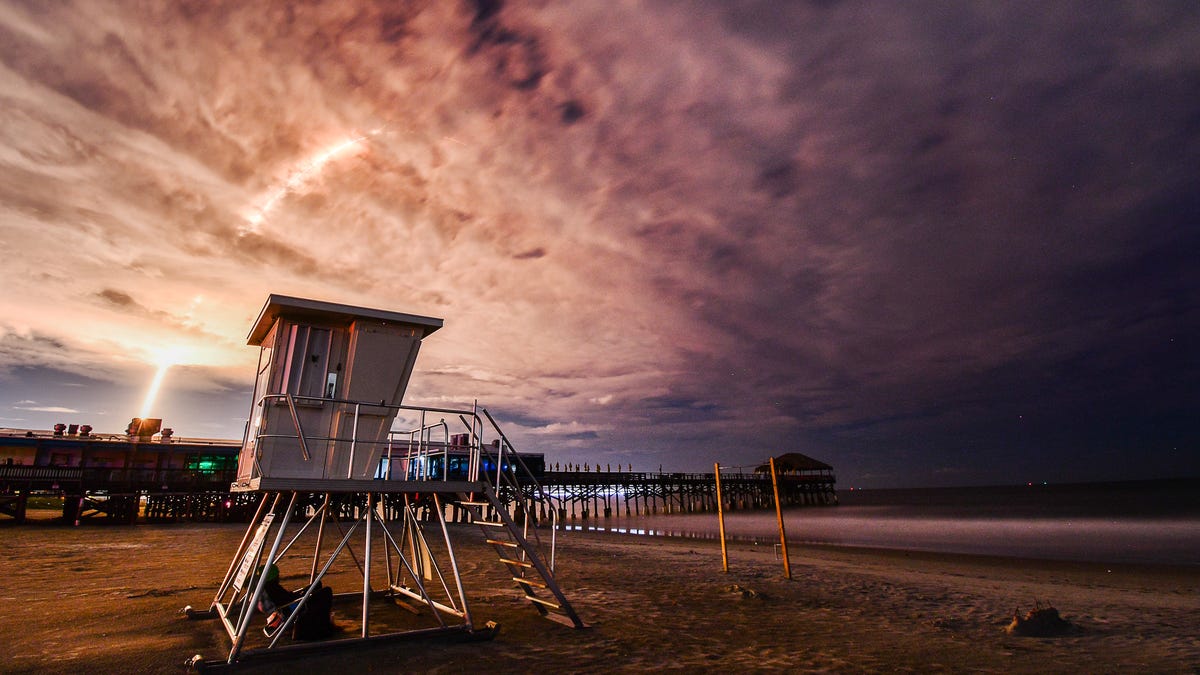Launch recap: Scroll down to review live updates from the Thursday, Sept. 18, liftoff of a SpaceX Falcon 9 rocket from Cape Canaveral on the Starlink 10-61 mission.
Original story: Rise and shine: SpaceX is targeting 5:30 a.m. to send a Falcon 9 rocket into flight from Cape Canaveral Space Force Station on another Starlink mission.
Welcome to FLORIDA TODAY Space Team live coverage of today’s SpaceX Starlink 10-61 mission. After lifting off from Launch Complex 40, the Falcon 9 will deploy 28 Starlink internet satellites into low-Earth orbit. For reference purposes, sunrise will occur at 7:09 a.m. at Cape Canaveral.
The Space Force’s 45th Weather Squadron predicted 65% odds of “go for launch” conditions, with cumulus clouds looming as the top threat.
No Brevard County sonic booms should occur. After soaring skyward along a northeasterly trajectory, the rocket’s first-stage booster will target landing aboard a SpaceX drone ship out at sea about 8½ minutes after liftoff.
Update 5:38 a.m.: The Falcon 9 first-stage booster just landed aboard SpaceX’s drone ship Just Read the Instructions in the Atlantic Ocean, completing its seventh mission.
9/18/25 5:35 AM | We have deactivated our launch operations support team after a successful launch of the SpaceX Falcon9 rocket.
— Brevard EOC (@BrevardEOC) September 18, 2025
Update 5:30 a.m.: Liftoff! SpaceX has just launched the Falcon 9 carrying 28 Starlink satellites from Cape Canaveral Space Force Station.
Update 5:25 a.m.: SpaceX’s launch webcast is now posted above, right below our countdown clock.
Liftoff is scheduled in five minutes from Cape Canaveral Space Force Station.
Update 5:20 a.m.: Ten minutes before SpaceX’s Falcon 9 lifts off, the countdown appears to be proceeding as planned.
Following is a list of key remaining countdown milestones. T-minus:
7 minutes: Falcon 9 begins engine chill prior to launch.1 minute: Command flight computer begins final prelaunch checks; propellant tank pressurization to flight pressure begins.45 seconds: SpaceX launch director verifies “go for launch.”3 seconds: Engine controller commands engine ignition sequence to start.0 seconds: Falcon 9 liftoff.
Update 5:15 a.m.: This morning mission will mark the Falcon 9 first-stage booster’s seventh flight, SpaceX reported.
The booster previously launched NROL-69, CRS-32, GPS III-7, USSF-36 and two Starlink missions.
Following stage separation, crews expect the booster to land on the SpaceX drone ship Just Read the Instructions in the Atlantic Ocean 8 minutes, 24 seconds after liftoff.
Update 5:05 a.m.: A bit more than six hours after the upcoming liftoff from the Cape, SpaceX technicians will again try to launch another Falcon 9 from Vandenberg Space Force Base in California.
That West Coast rocket, which is loaded with 24 Starlink satellites, went deep into the countdown Wednesday — 38 seconds before liftoff — before unfavorable weather triggered a scrub.
Update 4:57 a.m.: Falcon 9 fueling procedures are now taking place at Launch Complex 40, visual cues indicate.
That means this predawn Starlink launch window is locked in to lift off at 5:30 a.m. without any delays, or else the launch must be postponed to a later date.
Update 4:45 a.m.: Brevard County Emergency Management officials have activated the agency’s launch operations support team ahead of SpaceX’s upcoming Falcon 9 launch.
Update 4:35 a.m.: The National Weather Service reports partly cloudy skies at Cape Canaveral Space Force Station with a temperature of 76 degrees, a 5-mph northeast breeze and 10-mile visibility
But of note to SpaceX launch fans, NWS radar from the Melbourne Orlando International Airport station shows zero significant cloud cover across Brevard County.
Update 4:25 a.m.: SpaceX’s upcoming Falcon 9 launch will clock in as the 79th orbital rocket launch thus far during 2025 from Cape Canaveral Space Force Station and NASA’s Kennedy Space Center.
Click here for the FLORIDA TODAY Space Team’s updating tally listing all of this year’s missions, complete with photo galleries and story links.
Update 4:12 a.m.: NASA and Northrop Grumman are targeting about 7:18 a.m. for the Cygnus XL cargo spacecraft to dock with the International Space Station.
The Cygnus XL, which is packed with roughly 11,000 pounds of cargo and scientific equipment, launched Sunday evening from Cape Canaveral Space Force Station. But en route to the ISS, the main engine shut down earlier than planned during a pair of rendezvous burns, NASA reported.
“Cygnus XL’s trajectory placed the spacecraft a safe distance behind the space station while engineers assessed the spacecraft and developed its alternate burn plan,” a Monday NASA blog post said.
“Data shared by the spacecraft confirmed that Cygnus XL operated as intended during two planned maneuvers when an early warning system initiated a shutdown command and ended the main engine burn because of a conservative safeguard in the software settings,” the post said.
Update 3:59 a.m.: More information from the 45th Weather Squadron’s forecast narrative:
“A weak boundary will drift southward across Florida late this week. Regardless of the locationof that boundary during either launch window, cumulus clouds are expected to pose the primary threat of a weather violation,” the narrative said.
“Although these clouds are likely to be isolated-to-scattered, a concentrated band of moisture bringing more cloud cover and longer periods of unfavorable conditions to the Cape is possible,” the narrative said.
“Outside of that situation, most of the cloud tops should remain at, or below, flight-through levels but some tops may extend high enough to require more standoff distance,” the narrative said.
For the latest news and launch schedule from Cape Canaveral Space Force Station and NASA’s Kennedy Space Center, visit floridatoday.com/space. Another easy way: Click here to sign up for our weekly Space newsletter.
Rick Neale is a Space Reporter at FLORIDA TODAY. Contact Neale at Rneale@floridatoday.com. Twitter/X: @RickNeale1

